VW’s largest-ever vehicle – the three row/seven-passenger Atlas – is powered by an engine not much larger than the one that powered the old Super Beetle, which was the smallest (and lightest) car VW ever made.
It’s an interesting juxtaposition – and a telling sign of the times.
What It Is
The Atlas, per above, is the largest vehicle VW has ever offered for sale. It’s a full-size crossover with three rows of seats and room for 6-7 passengers (depending on the seating configuration). It competes with other large crossovers in the same general price range, such as the new Mazda CX90 (reviewed here) and the just-launched Toyota Grand Highlander (which is larger than the regular Highlander), the Honda Pilot and the Kia Telluride.
This big VW used to be available with a 3.6 liter V6. It now comes standard (and only) with a turbocharged 2.0 liter four that’s only slighter larger than the 1600 cc (1.6 liter) four that powered the VW Super Beetle back in the ’70s.
The good news is it makes nearly six times as much power. The bad news is it’s still not much engine for this much vehicle.
Prices start at $37,995 for the base SE trim with front-wheel-drive. VW’s 4Motion all-wheel-drive is available optionally, raising the MSRP to $38,895. The SE comes standard with a heated steering wheel, a digital instrument cluster, a 12 inch secondary LCD touchscreen, adaptive headlights and three-zone climate control.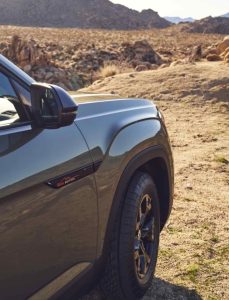
It also comes standard with more interior room – for cargo, particularly – than one of its main rivals (the Mazda) though not quite as much as the new Grand Highlander, which is now the largest vehicle in the class.
The next-up SE with Technology stickers for $42,100 to start and this one comes with a higher (5,000 lb.) maximum towing capacity plus a 20-inch whee/tire package and the option to buy a panorama glass sunroof (this isn’t available with the SE).
There’s also a new Peak Edition, which comes standard with the panorama sunroof and a set of 18 inch wheels with all-terrain tires, plus some unique-ti-this-trim interior and exterior styling differences.
A top-of-the-line SEL Premium R-Line ($52,890) comes with 21 inch wheels, diamond pattern seat inserts, automated self-parking and a 12 speaker Harman Kardon premium audio system, among other upgrades.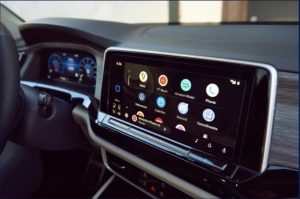
What’s New for 2024
The major change for the new model year is the taking off-the-table of the previously available 3.6 liter V6. Ventilates seats and the new/larger (12 inch LCD touchscreen are also standard in all trims.
In addition, VW has added the Peak trim mentioned earlier. Though not a serious off-roader, this version of the Atlas is best equipped to drive off-pavement on account of its 18 inch wheels and all-terrain tires.
What’s Good
A VW that seats as many as three Super Beetles.
Much less expensive to start than only slightly larger, slightly roomier Toyota Grand Highlander (base price $43,320).
No extra charge for heated seats or steering wheel.
What’s Not So Good
No more available V6 (the Mazda CX90, Honda Pilot and Kia Telluride still come standard with sixes . . . for now).
No significant gas mileage improvement with the new/standard turbo four.
$4k price bump to get 5,000 (vs. 3,500) pound max tow rating, which requires buying the $42,100 SE w/Technology trim or one of the other even more expensive trims.
It’s a measure of the times that a vehicle the Atlas’ size – and weight – comes only with a comparatively tiny 2.0 liter four cylinder engine. In the past, an engine that size would be considered about the right size for a car like a ’70s Super Beetle, which only weighed about 2,000 pounds.
The Atlas weighs more than twice that – 4,343 lbs. for the lightest front-drive version; with the optional AWD system, an Atlas weighs 4,517 lbs. That’s heavier than the heaviest V8-powered Detroit land yacht sedans of the ’70s.
And they had V8s!
The good news is this four makes almost as much power as the V8s of the ’70s and – more to the point – almost as much power as the 3.6 liter V6 that used to be the Atlas’ optional powerplant. The latter made 276 horsepower. The now-standard four makes 269 horsepower (which is also nearly six times as much power as a ’70s Super Beetle’s 1.6 liter, 48 horsepower four mustered).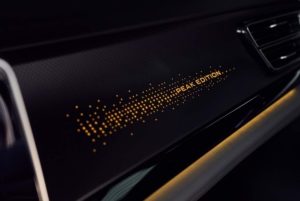
So the Atlas hasn’t been appreciably de-powered as a result of this under-the-hood-downsizing. But there’s little appreciable gain in gas mileage, which is 20 city and 27 highway vs. 18 city, 24 highway for the no-longer available V6. That 2-3 MPG difference doesn’t make much difference at the pump or the pocketbook.
But it makes a big difference – for VW – in terms of reducing the “emissions” of the gas that doesn’t have anything to do with pollution.
Every automaker is under pressure to cut “emissions” of carbon dioxide – and the easiest way to do that is by putting smaller and smaller engines in vehicles, even big ones, and using a turbo to boost their power on demand. The rest of the time – as when creeping along in bumper-to-bumper traffic – the engine is smaller and so are its “emissions” of the dread gas that plants metabolize into the oxygen we need to breath in order to stay alive.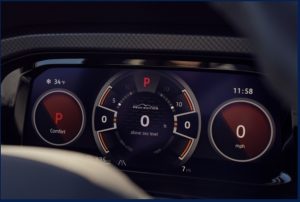
VW is not the only vehicle manufacturer trying to make do with less. The just-revised Toyota Highlander also no longer offers the V6 it used to – for exactly the same reason. Mazda still puts a standard six in the CX-90, but it’s paired with a mild-hybrid set-up, to accomplish essentially the same purpose as VW and Toyota have by replacing their sixes with turbo fours.
On the upside, the Atlas’ turbo four does not require premium gas to deliver its maximum-rated power. And because there’s still an engine under the hood – rather than a battery – you can drive 500-plus highway miles before you have to stop for more gas.
And that stop will only take a few minutes rather than 30-45 (or more) for a partial charge, if you were driving a battery powered device.
On The Road
It is remarkable what VW (and others) have been able to do with so little. Go back even ten years and it’d have been unthinkable to put anything smaller than a V6 in a vehicle this big.
In a vehicle this heavy.
Yet the comparatively tiny four under that wide and long hood manages to get the two-ton-plus Atlas to 60 in just over seven seconds. Remarkable. Astonishing, really. And it does it without seeming to strain much.
That little engine is under a lot of pressure to make V6 power. It may not be revving to redline and making the sounds of straining but the pressure is building (literally) every time you depress the accelerator pedal. The upside is more get-you-going power (this is a good way to think of the torque produced by an engine) which makes it feel as though the engine’s not working very hard to get you going. The 2.0 liter four makes more get-you-going power – 273 ft.-lbs. of torque – than the no-longer-available 3.6 liter V6, which made 266 ft.-lbs. – and not until the engine was spinning at 3,500 RPM (vs. just 1,500 RPM for the turbo four).
The result is the turbo-four-only Atlas feels stronger and more relaxed getting going than the V6-powered Atlas. But it is under more pressure (again, literally) to get you going, even if it doesn’t sound like it is.
In the past – when turbos were power-adders rather than displacement replacers – you usually got to hear them whistle as they spooled up. That was music to the ears of turbo-fanciers.
More, please!
But there’s less here. In fact, there’s none. The only way you can tell there’s a turbo is by reading the paperwork. VW has damped the sound to nil. The turbo four-only Atlas is actually quieter than the old V6-powered Atlas, which made V6 sounds when its engine revved to get you going.
It’s much quieter now – even though there’s more going on.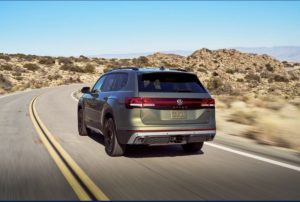
Otherwise, the driving experience is similar, which is unusual – for a VW. This is, after all, a company that built itself into a powerhouse selling small cars, not full-sized crossovers. But small cars aren’t much good as family vehicles – and the Atlas is very good at that. Instead of needing a Jetta and a Golf, all you need is just one Atlas.
At The Curb
The Atlas lives up to its name.
At 200.7 inches long, it is about three feet longer than the smallest car VW used to sell – the classic Beetle – which was just over 163 inches long. The Atlas also has enough room to carry most of a disassembled classic Beetle in the cargo area – 96.6 cubic feet of space. This is significantly more cargo space than is offered by the Mazda CX90 – which has 74.2 cubic feet of total available space (and just 14.9 cubic feet behind its third row vs. 20.6 for the VW) and very close to the new class-leading Grand Highlander’s 97.5 cubic feet total and 20.6 behind its third row.
The Atlas can also carry about twice as many people as could realistically fit inside an old Beetle, which was four – uncomfortably.
There’s more room for your legs, elbows and heads in the Atlas’ third row than there was in the Beetle’s second. And the Beetle wasn’t available with second row captain’s chairs, which are optional in the Atlas.
As mentioned already, the previously available V6 is gone but VW has added some compensatory standard features, including heated and ventilated seats for all trims, a 12 inch secondary touchscreen display and a digital instrument display. The switch to larger and larger digital interfaces is of a piece with the transition to smaller and smaller engines but for different reasons. New vehicles have so many features now that there’s not enough space for all the buttons and switches you’d need to control them. Hence their integration into displays that can house a limitless plethora of icons and scroll-through-them menus.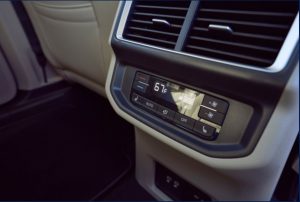
There are still a few physical buttons here, though – to control the AC/heater – and that’s a pleasantly retro (and functional) touch, so to speak. Higher trims have more smart-phone-esque touchscreen controls.
The new-for-2024 Peak trim is in keeping with the popular “overland” trend that emulates Subaru’s crossovers, which have always offered a higher level of rough weather and off-pavement capability. But Subaru does not offer the higher level of capability (i.e, the Wilderness package) with its largest crossover, the Ascent – which is significantly smaller and less roomy than the Atlas. Neither does the Honda Pilot, which is also a bit smaller and has about 10 cubic feet less total cargo capacity (87 cubic feet) but does have seating for up to eight and does still come standard with a V6 engine.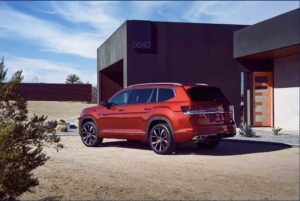
The Kia Telluride is another possible Atlas cross-shop that still comes standard with a V6 and more “overlanding” capability – but it’s a smaller vehicle (196.9 inches) with a less roomy interior and less total room for cargo (87 cubic feet). It also looks more like the SUV it isn’t – not (per Seinfeld) that there’s anything wrong with that. Like the other crossovers in the Atlas’ class, the Kia is based on a FWD layout with AWD (not 4WD) available optionally. But it does look more a 4WD SUV, if you’re wanting that look.
The Atlas offers a different look.
VW also offers another look – in the form of the Atlas Cross Sport. It’s the same basic vehicle, with the same basic features but shortened to 195.6 inches. It’s also lower (by about two inches) and has a fastback rear-end treatment. It’s the more stylish but less roomy – for people – iteration of the two. It does not offer a third row – but it does offer 40.3 cubic feet of cargo capacity behind its second row, which is about twice the space available behind the regular Atlas’ third row.
The Bottom Line
Small things now come in big packages . . .
. . .
If you like what you’ve found here please consider supporting EPautos.
We depend on you to keep the wheels turning!
Our donate button is here.
If you prefer not to use PayPal, our mailing address is:
EPautos
721 Hummingbird Lane SE
Copper Hill, VA 24079
PS: Get an EPautos magnet or sticker or coaster in return for a $20 or more one-time donation or a $10 or more monthly recurring donation. (Please be sure to tell us you want a magnet or sticker or coaster – and also, provide an address, so we know where to mail the thing!)
If you like items like the Keeeeeeev T shirt pictured below, you can find that and more at the EPautos store!



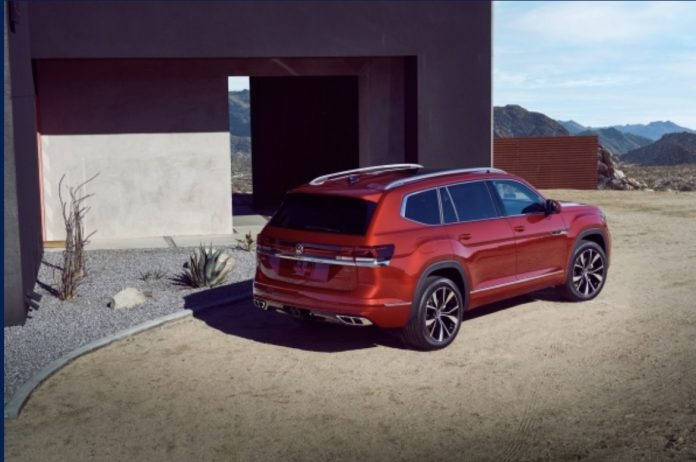


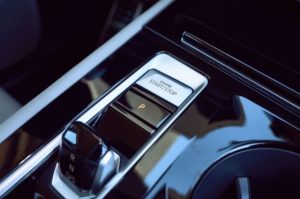
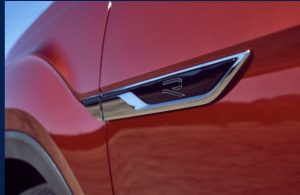








OT: It’s a shame no one can produce a nice 2.2L inline six with turbo. Inherently balanced, so quiet and no rattle. I guess that’s not efficient though, so the EU says no.
But then who cares in these days of active dampeners on Honda’s V6? Get rid of vibration from deactivating three of six cylinders with an electric servo.
“The only way you can tell there’s a turbo is by reading the paperwork. VW has damped the sound to nil.”
If you replace the factory air box/air air cleaner with an after market cone filter, you will hear the diverter valve releasing the turbo boost pressure back into the turbo inlet pipe…..
‘The turbo four-only Atlas is actually quieter than the old V6-powered Atlas, which made V6 sounds when its engine revved to get you going.’ — eric
Clearly, this calls for an enhanced soundscape, with V6 noises and vibrations piped in.
Thus, the intrepid Atlas owner becomes the heroic pilot Walter Mitty, riding the mesmerizing thrum of his bomber’s nine-cylinder radial engines through the flack, to deliver heroic blows against the Axis powers.
Or one could just buy an Apple Vision Pro for less than one-tenth the price, and skip the ‘Atlas’ b.s. altogether. Vroom, vroom!
Nice review. I bought an early 2018 with the V6. SE trim. Its actually one of the best cars I’ve ever owned aside from my 2014 Cayenne Diesel.
The car would be perfect with that TDI but I just ticked over 120k miles. Oil changes tires wiper blades and brake pads have been my only expense. It’s roomy and damn comfortable on the road.
I use it mainly for my business but when I need to take 6 people to the springs for the weekend this is ride of choice.
My only complaint is the gas tank is a bit small. 360 miles is about the limit. I think the early models were intended to get the TDI so the smaller tank was not an issue.
But as a long term owner of one I’d recommend it to anyone without hesitation.
I do however prefer the more European looking interior to the new ones. Way too busy for my tastes and new emblem looks too much like a cell phone icon.
Undersized engines are a bad idea for those buying for long term. Just too small. They may be ok, when new, but when they are ten, they will not be very good anymore. But I suppose that is a feature not a bug according to VW…….
Nice review! I’m a vw fan – I’ve owned examples from every decade since the 70s.
My wife drives a 2015 Passat with the 1.8T and it is pretty much the same weight and quickness of the 1998 manual I used to own. Good engineering, even if it has the dreaded DI.
I’ve driven a few of the Atlas and enjoyed them very much, even if I have no need for one. Somehow VW still manages to make their vehicles seem more substantial than a lot of others. The doors actually make a satisfying thunk!
Thanks, Yeti!
I still miss the TDIs, though. Especially the V10 that was once offered in the Touareg, also no longer offered.
I used to own 4 cars. I am now down to 2 cars. A 2001 Mustang Cobra SVT convertible and my mini-van/CUV like Traverse. I looked at the Atlas, Maszda CX-90 and others and I settled on the Traverse as I wanted a powerful 6 and lots of interior space. BTW the Traverse will be a 4 cylinder turbo for 2024.
The auto insurance is taking a large bite out my budget as itz costing me about $2,400 a year for full coverage even though I don’t drive a lot and am into my mid 70’s. I think itz going to get worse. You cannot believe how many people in my county drive without insurance.
Too bad the Atlas people downsized the engine. It would have been something with a possible V6 turbo running on regular gas and available on the base SE version. I would have seriously considered that. I have previously owned owned two VW’s, a ’72 Karman Ghia and the ’77 Scirocco. They were sporty poor man’s versions of expensive sport cars using 1.6 and 1.7 litre engines. I didn’t have a lot of money back then and even gas at 50 cents a gallon for me was pricey. I have graduated to V6 and V8 engines because I like the sound of power. No more 4 cylinder cars for me unless the government/car companies force me.
Hi Euro –
I ought to have mentioned in the article that the perfect engine for the Atlas would have been a TDI V6. But – of course – VW had to take those off the market. Because they were too efficient. Because they made EVs look ridiculous.
Yep the diesels were and still are the most efficient. Audi produced a all aluminum with a ceramic diesel. Which naturally was never allowed stateside. I seem to remember 75-100+ mpg. I wanted a 324td with a 5spd. Forget about it. I ended up with a 524td automatic which was the only offering allowed. No manual stick for u buddy. At least in 85 the e28 5series was still a reasonable sized sedan. It was a great car and a fantastic small straight 6 TD engine. You could run it wide open indefinitely at 128mph on the highway with the sunroof open with minimal noise. And still return decent fuel efficiency. The only negatives were it was heavy and the diesel even heavier on the frontend. And it had a timing belt which is rolling the dice on such high compression designs. I saved a handful locally from the landfills. Most of which had busted belts which resulted in sections of the hollow camshaft blasted clean out of the bore along with most all valves bent. I wanted to transplant one into a TR6. But that never quite materialized.
DD
Atlas gas mileage, which is 20 city and 27 highway…
Compared to the average EV which gets 25 mpg….if you calculated the amount of fuel burnt at the power plant to generate the electricity….
the average EV which gets 25 mpg….but they are less efficient on the highway….so would get less then that on the highway….compared to the Atlas’s 27 mpg highway….
then when it is very hot or cold the EV’s mpg could drop up to 50%….the Atlas’s 4 cyl ice engine 20 city and 27 highway, doesn’t change with the temperature…..
In some countries it costs more to fuel an EV then an ice powered car….no fuel savings with an EV….but way longer fuel stops…10X longer…..
An EV version would weigh another 1000 lb because of the stupid, dangerous, short life, lithium fire bomb battery….
An EV version would depreciate far, far quicker, the biggest cost in a vehicle….so would cost far more and have a lot higher purchase price too…
An EV version would take far longer to refuel, after driving all over looking for a functioning charger…lol….wasting half your day…..then at full throttle the EV has to be refueled after 100 miles….if towing something after 80 miles….lol….an ice powered one can go on long trips….
If you are lucky the EV version’s battery would last 100,000 miles, then you are looking at a $20,000 to $40,000 bill to replace the battery.
An EV version weighs a lot more, another 1000 lb…. so would eat tires…costing you a lot of money for tire replacements in 100,000 miles….you will get sick of replacing tires….
The engine in the Atlas EV happens to be the best 4 cylinder engine ever made, so it could go 200,000 miles or more before a rebuild…some diesel versions of it lasted up to 600,000 miles…it is a very strong engine…it is an evolution of a 4 cylinder engine that VW got when it bought Audi from Mercedes Benz…..Mercedes Benz…the best engineers in the world….
For example Pagani uses Mercedes Benz engines too, so does Aston Martin…..
The Pagani Huayra replaced the Zonda in 2011 and boasts a 720-hp twin-turbocharged V-8 engine sourced from Mercedes-AMG. Then there’s the Huayra BC Roadster—only 40 were produced, and they cost $3.4 million.
Nobody says Pagani has a crappy engine….but….when Porsche used an evolution of a Mercedes engine…in the 924….the entire brain dead car journalist gang, bad mouthed it….lol….how stupid were they?…..
The engine in the Atlas EV …..should be ….The ice engine in the Atlas